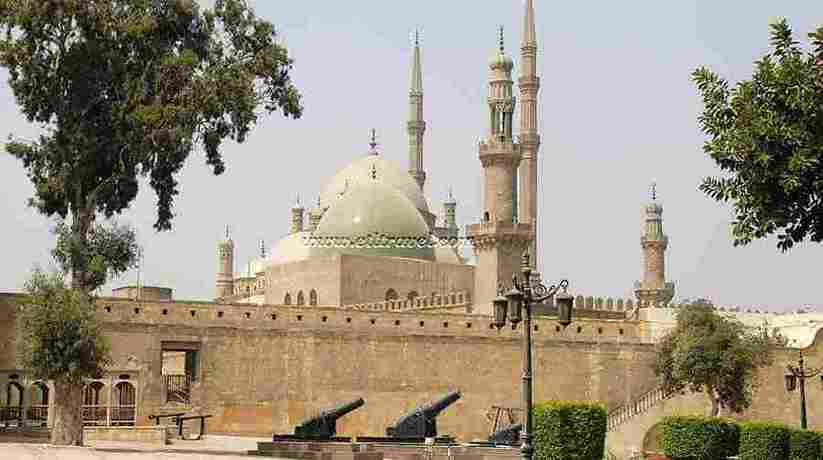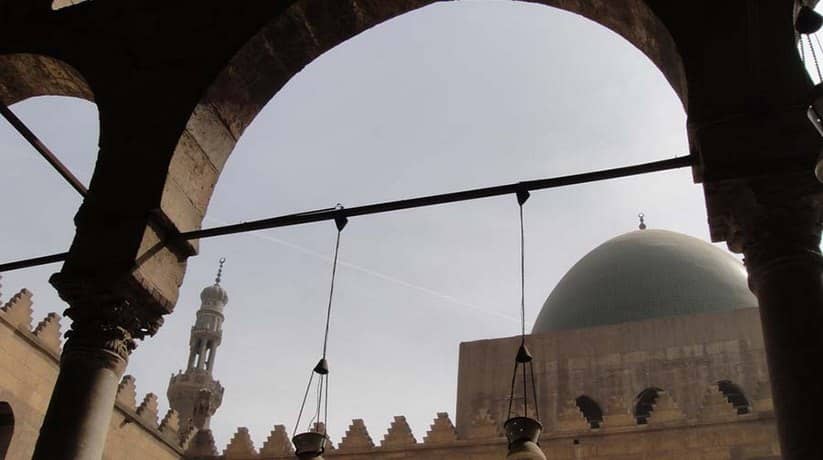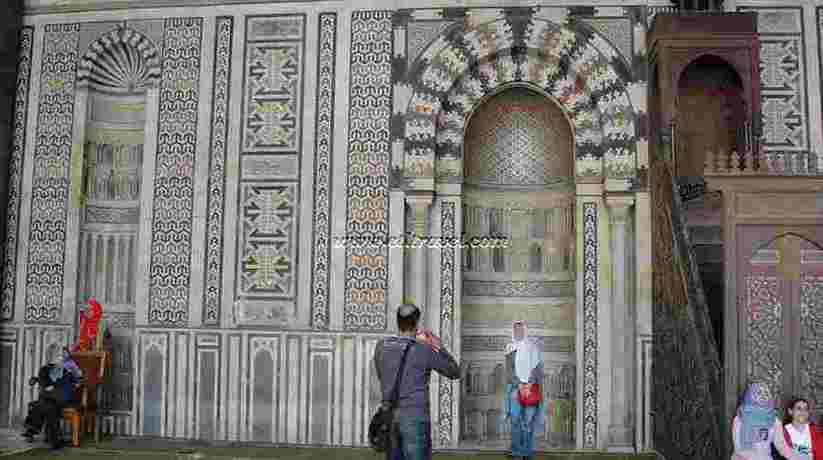Al Nasir Muhammad mosque Cairo Egypt tours, booking
Al Nasir Muhammad mosque Cairo was the royal mosque of both the Citadel and Cairo itself. In fact, Al Nasir Muhammad mosque Cairo built by Sultan Al Nasir Muhammad in Cairo citadel. It was during his third and longest reign in 1340. The Sultans (kings) of Cairo performed their Friday prayers in it, except on religious feasts. In feasts, prayer took place in a large gathering at the hippodrome beneath the Citadel walls. The mosque in fact was large enough to hold five thousand worshipers. Moreover, the main entrance to Al Nasir Muhammad is across the entrance to the courtyard of Mohammad Ali mosque. The Citadel always had a mosque. The mosque is like most of the buildings which built on the site of a previous building.
In fact, there were several mosques in Cairo Citadel. The mosque was one of the most glamorous in Cairo. It was until the original dome covered with green tile over the nine-bay Maqsura. Maqsura is a private area in the prayer hall. In fact, it usually enclosed by a wood screen for the ruler and his entourage. It collapsed in the sixteenth century. Furthermore, the marble carried off by the Ottoman conquerors. In fact, Al Nasir Muhammad mosque Cairo founded in 1318. It pulled down and rebuilt on a larger scale in 1335. This hypo-style mosque built as a regular free-standing rectangle around a courtyard. It was with a large dome covering the prayer niche area. The mosque has three entrances. One is on the northeastern side with a trilobed shallow recess. Moreover, another one is on the northwestern wall with a stalactite portal.
Further details about Al Nasir Muhammad mosque in Cairo:
The third entrance is on the southern wall. It adorned with a pointed arch including a sun-rise motif in Ablaq masonry. None of the entrances has a Maksala or bench, making them the exception to the rule in Cairo. The facades of Al Nasir Muhammad mosque not paneled. They have no decoration except crenellation. The appearance is rather austere. It is except for the two exotic minarets at the northeast corner and at the northwest portal. They decorated with blue and green faience mosaics. Moreover, the minaret to the north directed its call to prayer to the officers and soldiers dwelling there. The other minaret faced the sultans’ palaces. The northern minaret is the taller of the two. That is why it could seen by the palace house some distance away. Both minarets built of stone.
The western minaret is conical, with a shaft which carved in a deep zigzag motif. It is vertical on the first story and horizontal on the second. It has no openings and has a garlic-shaped bulb resting on a ribbed, tapered cylinder. The whole upper structure covered with green, white and blue faience mosaics. It is like those which found at Al Nasir’s Sabil attached to the madrasa. In fact, this madrasa (school) built by his father, Qalawun. A Quranic inscription band made of white faience mosaic adorns the nick of the bulb. This minaret continues the Cairene tradition of placing minarets at the portals of foundations. The minaret at the northeastern corner of the mosque has a completely different shape. The base is rectangular and the second story is cylindrical.
More details about the mosque:
In fact, both are without carving. Its upper part has an open hexagonal pavilion. Moreover, it supports the top of the structure, which is like the top of the western minaret. Both minarets have balconies adorned with parapets. They made of stone panels pierced with arabesques. Furthermore, they carved in the same technique used to make the screens of Sanjar. The crenelation around the base of the bulbous is the earliest which known experimentation. This is with technique at the base of a Cairene dome. A craftsman from Tabriz came to Cairo during the reign of Al Nasir Muhammad. He was the one who built other minarets covered with faience, as was the fashion in Persia. The bulb shape also came from Tabriz technique, but also the bulb shape, seem to have come from Tabriz. Both minarets also have another common feature.
It distinguishes them from all other Mamluk minarets. Moreover, their base is below the level of the roof of the mosque. It is when the roof of the mosque rebuilt, the minarets were already standing. On the northern wall of Al Nasir Muhammad mosque underneath the minaret is a small balcony. It reached by a staircase inside the mosque. Its function is unknown. One may speculate that it intended for prayers or recitations addressed. This is to overflow crowds of worshipers outside the mosque. Furthermore, the interior of the mosque follows the hypo-style scheme. It is with the standard pattern of a rectangular courtyard. A sanctuary on the Qibla side and arcades surrounding its other three sides.
Further details about the mosque:
In fact, within Al Nasir Muhammad mosque, the walls supported by the arcades. They have a row of arched windows that give the building a special character. These windows must added when the roof raised. The openings help reduce the thrust carried by the arches, admit light and are ornamental as well. The voussoirs of the Al Nasir Muhammad’s arcades composed of ablaq masonry. They are of the same stone, but painted. The ceiling over the arcades is flat. It covered with traces of its light blue. In fact, the silver decorations are still visible. The crenelation around the courtyard is of the stepped type. It differs from the outer crenelation composed of rectangles. It is with rounded tops like those of the city and Citadel walls. At the corners near the crenelations of the courtyard are four decorative structures. They are like the Mabkhara (incense burner) minaret tops.
A special collection of pre-Islamic capitals crowns the marble columns of the mosque. The two pairs of Coptic Christian capitals at the main entrance are particularly interesting. Their white marble carved with a basket pattern. There are also capitals dating to the Greek and Roman periods. Al Nasir Muhammad mosque had many large iron-grilled windows that now walled up. It also paneled with high marble dados. They later removed by Sultan Selim. They shipped to Istanbul with other marbles from the palace. The Qibla wall completely restored. The ground level inside the Citadel has risen. The mosque was a much higher level and reached by a staircase.
More details about Al Nasir Muhammad mosque in Cairo:
The present dome of Al Nasir Muhammad mosque in Cairo is modern. It carried by granite columns like those of the Citadel palaces. These columns taken from ancient Egyptian temples. The original dome, like many others in Cairo, made of plastered wood. The transition zone consists of pendentives carved with stalactites. They, together with the inscription band referring to the founder, painted and gilded. During the later Mamluk period, the stalactite squinches supplanted by stalactite pendentives. Pendentives are triangles at the corners of the transitional zone of a dome. They transfer the thrust of the dome to the corners of the four walls. The squinches are arches or quarter-domes. They transfer the thrust into the middle of each of the four walls.
















